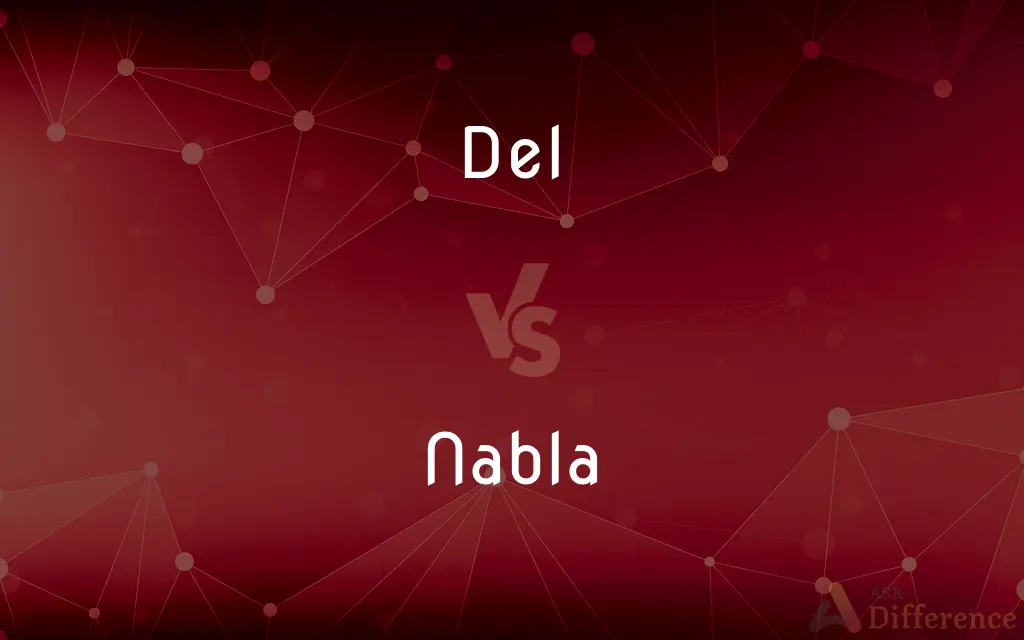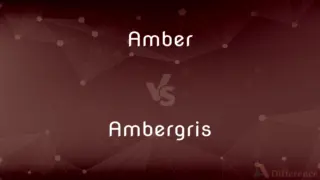Del vs. Nabla — What's the Difference?
By Maham Liaqat & Urooj Arif — Updated on March 19, 2024
Del is a differential operator symbolized by ∇, used in vector calculus, focusing on gradient, divergence, and curl. Nabla, the same symbol (∇), represents the del operator itself, emphasizing its geometric and operational roles.

Difference Between Del and Nabla
Table of Contents
ADVERTISEMENT
Key Differences
Del is a fundamental operator in vector calculus, representing a way to denote gradient, divergence, and curl of a field. It's essential in physics and engineering for describing spatial variations. Whereas nabla is the name of the symbol (∇) used for the del operator, derived from the shape of a harp, which the symbol resembles.
Del operator is utilized to express operations over scalar and vector fields, providing a concise notation for complex differential operations. On the other hand, the term nabla, referring to the symbol itself, is less about the operations and more about the symbolic representation and its history.
In terms of usage, del appears in mathematical expressions to denote specific vector calculus operations. It is a vector differential operator that acts on functions to produce vectors or scalars, depending on the context. Nabla, while essentially referring to the same concept, is often used in discussions about mathematical notation and the development of vector calculus.
The notation involving del (∇) simplifies the representation of mathematical concepts such as the gradient of a scalar field or the curl of a vector field. Whereas nabla's role is more in the linguistic and symbolic domain, emphasizing the shape and origin of the symbol used for these operations.
Understanding the del operator is crucial for students and professionals in fields requiring advanced calculus, highlighting its operational significance. Conversely, knowing about nabla might be more relevant for those interested in the historical and symbolic aspects of mathematical notation.
ADVERTISEMENT
Comparison Chart
Definition
A vector differential operator in vector calculus.
The symbol (∇) used to represent the del operator.
Symbol Origin
Derived from the symbol nabla (∇).
Named after the ancient Greek harp, resembling ∇.
Primary Usage
To denote gradient, divergence, and curl.
To symbolize the del operator itself.
Context of Use
Mathematical operations in physics and engineering.
Discussions on mathematical notation and history.
Importance in Mathematics
Essential for vector calculus and differential equations.
Important for understanding mathematical symbolism.
Compare with Definitions
Del
Del is represented by the symbol nabla (∇).
Del, or ∇, when applied to a vector field, can denote its curl.
Nabla
Nabla is the name given to the symbol (∇) representing the del operator in mathematics.
The nabla symbol is derived from a Greek harp's shape.
Del
Del is a differential operator used for denoting gradient, divergence, and curl in vector calculus.
The del operator ∇ applied to a scalar field results in the gradient.
Nabla
While often used interchangeably with del, nabla focuses on the symbol itself.
Discussions about nabla often involve its use in various mathematical contexts.
Del
It symbolizes mathematical operations over vector and scalar fields.
Del's application in electromagnetism is pivotal for Maxwell's equations.
Nabla
It refers specifically to the geometric shape and historical origins of the del symbol.
Nabla's design reflects its namesake, an ancient stringed instrument.
Del
Integral in physics and engineering for spatial variation analysis.
Del is used to compute the gradient of potential energy fields.
Nabla
Nabla is integral to the notation of vector calculus operations.
Nabla (∇) symbolizes gradient, divergence, and curl operations succinctly.
Del
It facilitates the expression of complex differential operations succinctly.
The divergence of a vector field is represented as ∇·A.
Nabla
Its significance lies more in notation than operational functionality.
Nabla is a key element in the formalism of mathematical expressions.
Del
Del, or nabla, is an operator used in mathematics (particularly in vector calculus) as a vector differential operator, usually represented by the nabla symbol ∇. When applied to a function defined on a one-dimensional domain, it denotes the standard derivative of the function as defined in calculus.
Nabla
A Hebrew stringed instrument.
Del
(analysis) The symbol ∇ used to denote the gradient operator.
Nabla
(analysis) The symbol ∇, used to denote the gradient operator.
Del
(mathematics) the symbol ∂, in the context of a partial differential
Del
(obsolete) a part, portion
Del
Abbr of delegate
Del
Abbr of delegation
Del
Abbr of delete
Del
Abbreviation of delineavit as seen on published artwork, identifying the original artist. Commonly seen in books and articles on topics in natural history
Del
Share; portion; part.
Del
A differential operator which, operating on a function of several variables, gives the sum of the partial derivatives of the function with respect to the three orthogonal spatial coordinates; - also called the gradient or grad. It is represented by an inverted Greek capital delta (
Common Curiosities
Can nabla and del be used interchangeably?
In practice, they often are, but nabla specifically refers to the symbol, while del refers to the operation.
What does the nabla symbol represent?
The nabla symbol (∇) represents the del operator, used in mathematical notation for vector calculus operations.
What fields of study use the del operator?
Physics, engineering, and mathematics, especially in areas involving vector calculus and differential equations.
What is the del operator?
The del operator is a symbol (∇) used in vector calculus to denote operations such as gradient, divergence, and curl on fields.
Is there a difference in how del and nabla are used in equations?
No, they serve the same function in equations, with del emphasizing the operation and nabla the symbol.
What is the gradient operation in vector calculus?
The gradient operation, denoted by del, measures the rate and direction of change in a scalar field.
How are del and nabla related?
Del is the operational concept in vector calculus, while nabla refers to the symbol (∇) used to denote this concept.
Why is the symbol called nabla?
It's named after the Greek word for a type of harp, which the symbol resembles.
Are there any specific symbols associated with operations involving del?
Yes, dot (·) and cross (×) symbols are used with del to denote divergence (∇·) and curl (∇×), respectively.
Why is the del operator important in electromagnetism?
It's used extensively to formulate Maxwell's equations, describing how electric and magnetic fields interact and propagate.
What is the significance of understanding the del operator?
It's crucial for mathematical analysis in vector calculus, aiding in understanding and solving physical problems.
What is the curl in vector calculus?
Curl assesses the rotation of a vector field around a point, indicating the field's circulation density.
What does divergence tell us in vector calculus?
Divergence measures the magnitude of a vector field's source or sink at a given point, indicating how much the field spreads out from that point.
How does nabla contribute to mathematical history?
Nabla's unique shape and its adoption into mathematical notation reflect the historical blending of geometric symbols and mathematical concepts.
Can the understanding of nabla enhance mathematical notation comprehension?
Yes, knowing about nabla helps in grasping the evolution and reasons behind the use of specific symbols in mathematical notation.
Share Your Discovery

Previous Comparison
Amber vs. Ambergris
Next Comparison
Wood vs. CardboardAuthor Spotlight
Written by
Maham LiaqatCo-written by
Urooj ArifUrooj is a skilled content writer at Ask Difference, known for her exceptional ability to simplify complex topics into engaging and informative content. With a passion for research and a flair for clear, concise writing, she consistently delivers articles that resonate with our diverse audience.














































